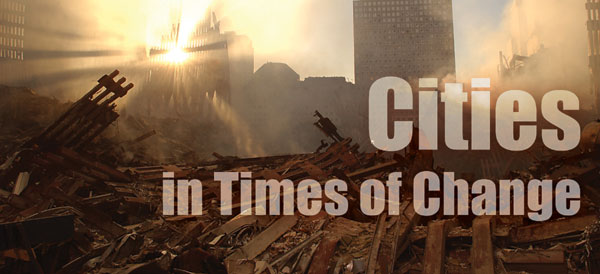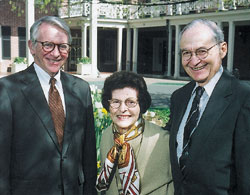

A publication of The Graduate School, University of North Carolina at Chapel Hill
Archives Fall 2002
Home | Back issues | About us | The Graduate School | UNC-Chapel Hill | Make a gift
 |
FEMA News Photo
|
| On Sept. 15, 2001, sun streams through the wreckage of the World Trade Center in New York. A year later, the city is exploring ideas for rebuilding the site. |
We
may be gathering lessons from the terrorist attacks of Sept. 11 for time
immemorial. The events of that day and its aftermath required Americans
to plan for emergency situations we had never faced before, and we found
that the need to stop and reflect is vital. At UNC a year after the Sept.
11 attacks, Chancellor James Moeser called together the community for
remembrance and a Volunteer Fair urged students to participate in more
public service.
But these kinds of reflections
took place on campus all year long. Last April, when Eugenie Birch described
for Chapel Hill listeners the impressive mobilization of people and planning
in New York City since the Sept. 11 tragedy, she said the important lessons
were not for New Yorkers alone.
“Successful places are
always examining themselves and reacting when things aren’t right,”
she told participants at the 10th Anniversary Weiss Urban Livability Symposium
at UNC.
Birch, a prominent historian
and chair-woman of University of Pennsylvania’s City and Regional
Planning Department, commended the willingness of residents, property
owners and government leaders in
lower Manhattan to rethink and redesign the 16-acre site of the collapsed
World Trade Center. The resilient response revealed a human strength in
a place that, she noted, has a long history of reinventing itself.
 |
| Photo by Will Owens |
| Mayor Joseph Riley of Charleston, S.C., left, spoke on his city’s issues at the Weiss Symposium in April. The symposium was made possible by Professors Emeriti Shirley and Charles Weiss, right. In April, the Weiss Symposium celebrated its 10th anniversary of exploring creative new approaches to community life. |
Birch was one of several visiting
and resident scholars who shared their expertise at the April 5 to 6 event
titled “Cities in Times of Change.” The Weiss symposium was
founded by Charles and Shirley Weiss, both emeritus professors at UNC.
With its interdisciplinary scope, the symposium reflects the overlapping
interests of the Weisses. Charles Weiss taught in environmental sciences
and engineering, Shirley Weiss in city and regional planning.
Birch, along with speakers Gil Jamieson, chief of mitigation planning with the Federal Emergency Management Agency; and Ron Atlas, president of the American Society of Microbiology; brought home how such interests come together in times of crisis, such as the Sept. 11 attacks and ensuing anthrax crisis.
For Birch, the key to coping
with crises is resiliency. Cities that succeed in meeting challenges,
she said, are those that, first, recognize the crisis. The problems are
not always as shocking as a terrorist attack—other issues are still
crucial, like shortages of affordable housing. Next, cities must respond
with creativity, visions and ideas. The ideas may not be new, but simply
right for the time.
“Ideas float,” said
Birch. “They can float for generations before they’re accepted.”
Finally, she said, to make
ideas work resilient cities need effective political leaders to carry
out the new plans.
While Birch stressed the value
of resiliency, Jamieson’s federal agency is focusing on sustainability.
Chief of FEMA’s mitigation planning branch, Jamieson said his organization
traditionally looked at ways to handle post-disaster planning. Lately,
the emphasis has shifted to spurring governments to make standards that
help communities withstand disasters like hurricanes or floods. He calls
that “choosing a path of disaster resistance.”
Since the attacks last fall,
Jamieson said, FEMA executives are extending their reach to the large-scale
damage that people may produce. “We’re just beginning to understand
how to estimate loss from man-made disasters, like for terrorist events,”
he said.
But the same principles apply:
the agency’s aim is to avoid damage. Anticipating a surge of federal
funding for national preparedness, FEMA faces a challenge to integrate
disaster planning down to local levels. Jamieson says that means ambitious
new training programs, extensive efforts to ensure that government agencies
buy equipment efficiently and meeting a huge demand to coordinate services.
Atlas, a key adviser to federal
agencies on microbiological terrorism, has had few moments to rest since
the anthrax crisis last fall. But the professor and graduate department
dean from the University of Louisville gave a high-energy speech, telling
the symposium audience that experts had been testifying in Washington
long before last September. Their message: the United States needs to
upgrade its public health protocols to cope with bioterrorism.
Since last September, Atlas said, the halls of Congress have echoed with questions and proposals about research, emergency responses and ethics. He outlined three requirements to better prepare the country: enhance public health capabilities, find new vaccines (a difficult achievement since scientists cannot ethically test human subjects), and greatly expand funding and research.
As Atlas noted, building defenses
against biological attack means establishing new forms of front-line response.
In this case, physicians become the first responders, not police or firefighters.
Because of the potential of
catastrophe, health planners are hurrying to build protocols that will
hold up in the event of a major threat. Such plans, Atlas explained, must
coordinate public health and law enforcement concerns — if another
anthrax case occurs, should the first task be to catch the “bad guys”
or to stop a potential outbreak?
From a research perspective,
the anthrax threat has spawned what Atlas called a growing debate about
the central purposes of knowledge. “I’m arguing that we need
to continue the open ways of communicating in science,” Atlas said.
“We need to know if people are at risk. What do we need to do to
protect the public?”
Clearly, the speakers favored
the chance to openly share their ideas on the UNC campus. The Weisses
themselves enjoyed the talks from their table near the front of the conference
room. Birch was making her first visit to UNC since 1984, and had a special
recollection about an important role model. “When I started my career,”
she said, “the only woman I could find who was active and publishing
in this field was Shirley Weiss.”
“It’s the sorts of
investments made by people like the Weisses that provides the margin of
excellence for graduate departments,” Atlas also noted.
And, that allow us to stop
and reflect on how to prepare cities in times of change.
-Glenn Scott
© 2002, The Graduate School, The University of
North Carolina at Chapel Hill
All text and images are property of The Graduate School
at the University of North Carolina-Chapel Hill. Contact Sandra Hoeflich
at shoeflic@email.unc.edu
to request permission for reproduction.